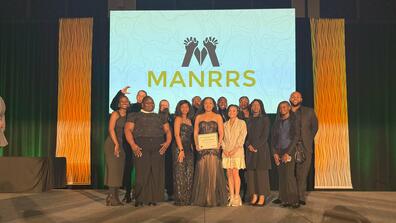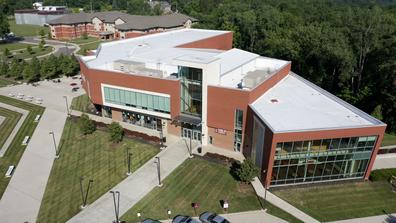Helicopter mechanic turns college professor

Early in his life, no one anticipated that Central State University Associate Professor of Art Jim Champion of the school’s College of Humanities, Arts, and Social Sciences (CHAS) would have ever become so deeply embedded in the scholastic realm. Least of all, Champion himself.
Champion never expected to attend college in the first place — until he found himself all but thrust into the field that has become such a vital part of his current career path.
“I grew up in Pascagoula, Mississippi and came from a family that was always making things,” Champion said. “So, I’ve always been a ‘maker.’ Some of my earliest memories are making things — out of wood, paper, plastic bottles, and stuff — and always being invested in that. It was never formal or anything like that. One time, I just took to building the entire helm of the Star Trek Enterprise in my backyard. (It) even had all the little ghost lights and switches and all. I was always doing stuff like that.”
Due in part to his dislike of formal, structured education in general during his time in grammar and high school, in conjunction with certain challenges he faced living with dyslexia and coupled with the reality that no one in his family had ever gone themselves, Champion never considered becoming a college student during his formative years. Meanwhile, his lifelong passion for “making things,” as he put it, acted more as a hobby than anything he thought he could pursue as a profession and certainly not as an educator in same.
“It was always just something I had done for fun and entertainment,” Champion said. “It was a natural thing for me.”
Champion finds passion in art
It was not until he was a junior in college, after a dramatic shift in his worldview, that Champion took a formal art class at all.
“I had been a helicopter mechanic working on the airframe, working on metal and things like that, for the Army,” Champion began. “And then in 1985 I had a heat stroke and developed epilepsy from that.”
Champion switched gears at that point toward acquiring a degree in higher education, courtesy of GI Bill. Even then, Champion was opting for pre-med to become a doctor or perhaps veterinarian.
After an advisor recommended taking a class in drawing to generate slides for his biology work, that childhood yen for artistic production was reignited and the maturing military student was set on the track that would years later lead him to where he is at Central State today.
The first medium that Champion worked with directly in this early stage of his pursuit was, unsurprisingly, metal — specifically, bronze casting.
“... The University of Alabama at Birmingham didn’t have a furnace on campus, and so I ended up finishing my degree at Ole Miss,” Champion said.
While at the University of Mississippi, Champion took his first ceramics class. Feeling “really connected to that,” Champion switched once again from bronze casting to ceramics as his main concentration. This choice was bolstered by the fact that bronze is an extremely expensive material to use, but it was also a matter of how much more directly one works with ceramic production — the tactile, hands-on element — that attracted Champion to what would become in many ways the great artistic passion of his latest life journeying.
“I’ve always liked learning, but in large part because of my dyslexia, I never intended on going to college — it was never a place I thought I should be,” Champion said. “It didn’t seem very conducive to my situation, seemed too structured, too little room for individual and nonlinear thought."
“But then once I ended up getting there and was going to college, I realized how different it really is, and that there are far less constraints on how you learn, the way you learn,” Champion added. “And then there I was, getting my degree, becoming the first person not only in my family but also my extended family to do so.”
Once that seal was broken, Champion continued onward, gaining not only his Bachelor of Fine Arts (BFA) with an emphasis on sculpture from the University of Mississippi but eventually a Master of Fine Arts (MFA) in Visual Arts with an emphasis on ceramics from the University of North Dakota, a graduate certificate from Hood College also with a concentration in ceramics, and — along the way — a Master of Arts (MA) in Arts Therapy from the University of Louisville.
Art therapy and flexible learning for disabled students
Champion’s interest in art therapy — guiding severely disabled or disadvantaged individuals in utilizing creative production as a means of mental and emotional health work — stemmed in large part from his own challenges with dyslexia and complications he has at times, distinguishing “right” from “left” due to being ambidextrous, in addition to a slight synesthesia in which his direct senses can be, as he put it, “a little bit different.” Such “differences” required that he become at a young age self-motivated and self-actualizing in innovative problem-solving.
He believes that this specialized background allows him to be an even more attentive and adaptive instructor at Central State, particularly for students who — like himself — may not have had much conventional success in previous schooling, may be first-generation college attendees, and may require a more unique and flexible learning program which Champion can intimately provide.
As much value as Champion found in his work as an arts therapist, the field is an extremely time-consuming one, and could also be emotionally draining to a point where there would be little time and energy left for personal creative production. As such, Champion decided yet again to take a different track, focusing once more on fine art, and received his graduate certificate from Hood in 2010 before gaining his MFA from North Dakota shortly thereafter in 2013.
During a two-week seminar at Gatlinburg, Tennessee’s Arrowmont School of Arts and Crafts, Champion became friendly with new colleague Allen Chen who was teaching at Central State at that time. Upon leaving to teach elsewhere, Chen recommended Champion for his then-vacant position. Champion applied, earned the spot, and has since 2014 been working first as an instructor, then as assistant professor, and finally as associate professor for classes ranging from Beginning Ceramics, Figure Drawing and Sculpture to Introduction to Art (art history), and, most recently, the Senior Art Show.
“I didn’t know much about Central State right up until I was applying,” Champion confessed. “But not every art school offers ceramics. So, just having that opportunity here was a great find. I was really excited at having that opportunity. And I’ve really enjoyed using my unconventional background and experiences in education to assist in working with my students. It all relates to how I teach at Central State.”


